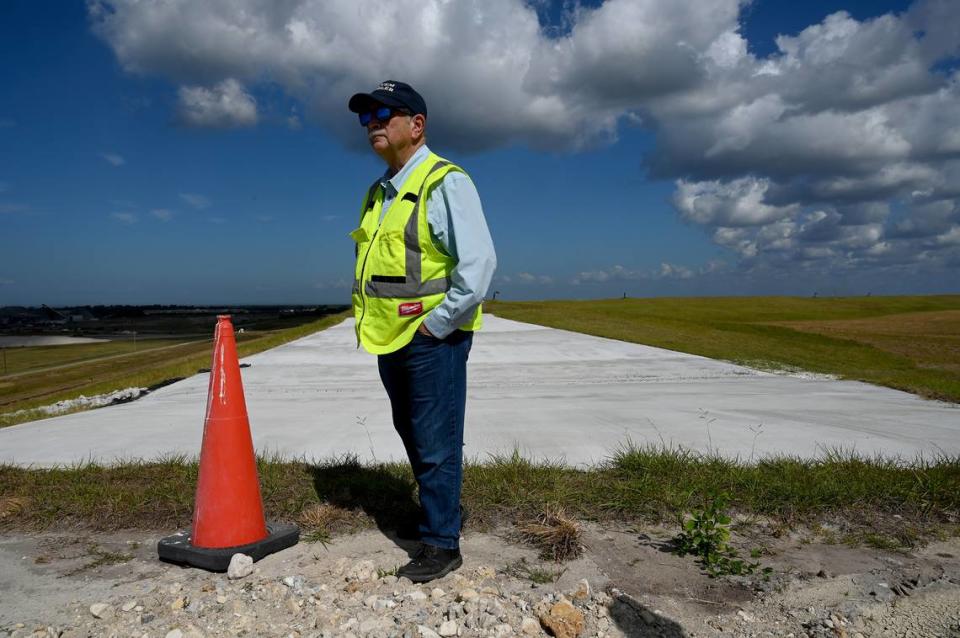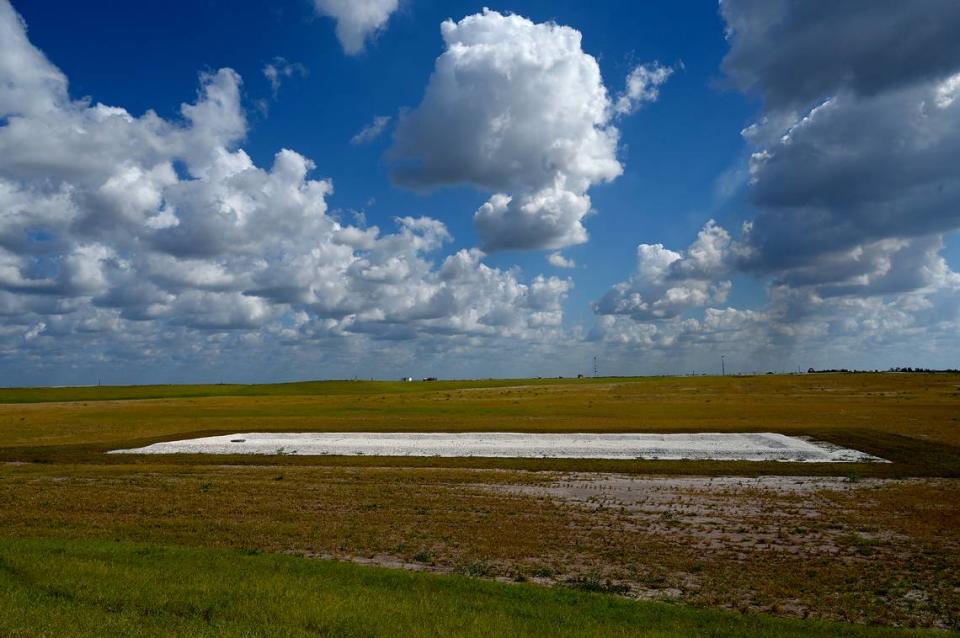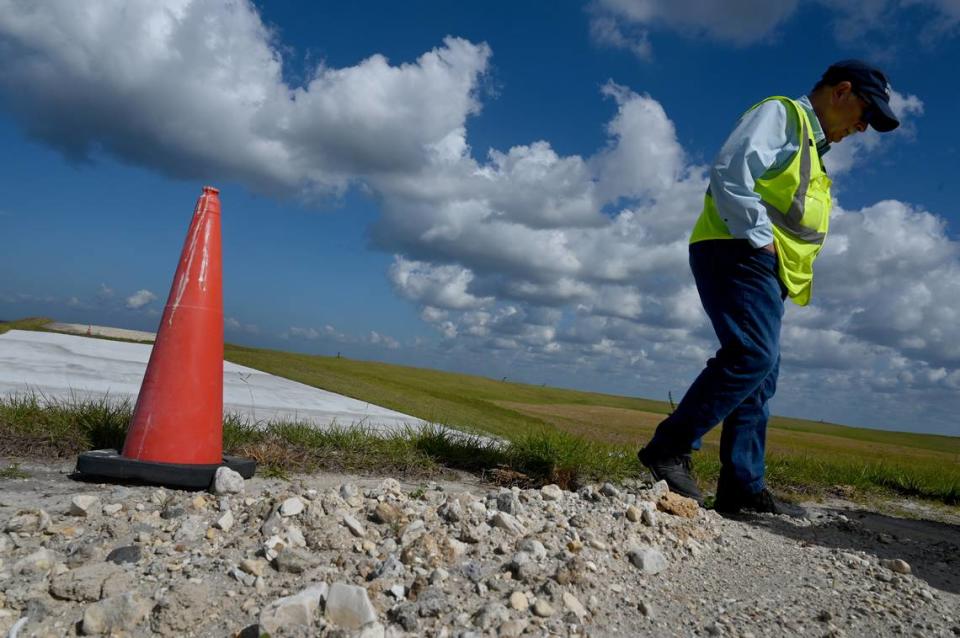A peek at the future? First closed pond at Piney Point is a ‘model’ for site shutdown
Another major milestone has been accomplished at Piney Point, where the first of four ponds has been closed for good after an environmental disaster in Manatee County.
Site operators are growing more confident about the former phosphate processing plant. In April 2021, a leak at the site triggered an emergency response and forced 215 million gallons of contaminated water to be released into Tampa Bay.
But conditions are steadily improving thanks to a state commitment to close the long-plagued site once and for all. This summer, site workers flipped the switch on a new underground injection control well that sends treated water underground, paving the way for the massive ponds to be filled with soil, capped with grass and outfitted with a complex drainage system.
“I’m ecstatic,” said Herb Donica, the court-appointed receiver in charge of day-to-day operations at Piney Point. “We finally have something to show the public. This is almost like the model home in a subdivision.
“We have a large area that used to hold toxic water,” he said. “Now it’s dry and when it rains, it will drain ... so the public will be safe. We don’t have the possibility of a burst or an overflow.”
Despite earlier suggestions that Piney Point could be revived as an industrial site or be made into a park, Donica said the facility will remain closed while monitored for the next 50 years.

Piney Point’s past
After opening in 1966, Piney Point operated for nearly 40 years. The site, which sits on the east side of Tampa Bay near Manatee County’s northern border, collected phosphate rock to be processed for phosphorus, a key ingredient in fertilizer.
Over the years, Piney Point accumulated large ponds of process water, a chemical byproduct of breaking down phosphate rock. That water, which is high in nutrients including nitrogen, phosphorus and ammonia, can have a negative impact on water quality.
In April 2021, a leak in one of the ponds set off an environmental scare, forcing the Florida Department of Environmental Protection to authorize the release of 215 million gallons of water into Tampa Bay. Local environmental scientists later said that the event likely contributed to an extended bout of red tide in the area.

But Piney Point began its operations before the Environmental Protection Agency was created to regulate industrial facilities that can create a public threat, Donica said.
“This dates back to the ‘60s,” he said “when business and technology ran ahead of public safety and created a lifetime of problems.”
Concerns remain along Tampa Bay
The recent progress at Piney Point has been due in large part to Manatee County Government’s underground injection well that switched on in April. The system pumps process water that has been treated to remove harmful nutrients about 2,000 feet below ground.
According to site operators, the well has already disposed of 110 million gallons of water. With less water on the property, site operators can direct their “full focus” toward closing the site.
“It has changed the entire dynamic,” said site manager Jeff Barath.
In a recent statement praising the first closed pond, the leader of Florida’s top environmental agency said he is confident that plans are heading in the right direction.
“I am thankful for the progress we have seen at Piney Point to date — including the work to secure and protect the site during two hurricanes — and am encouraged as the court-appointed receiver has completed this first phase of closure work,” Shawn Hamilton, secretary of FDEP, said. The agency “looks forward to the receiver’s continued work to expedite the next phase of closure and eventually the full closure of the facility.”

Dave Tomasko, executive director of the Sarasota Bay Estuary Program, also described the milestone as a significant accomplishment for the entire Tampa Bay region.
“It was literally the worst thing to happen to Tampa Bay and Sarasota Bay in 50 years,” Tomasko said, recalling 2021’s release of contaminated water. “This was a huge damaging event ... that set us back a long time. To not have to worry about that is a really big deal.”
Others called on state leaders to take action with stronger policies. In a statement provided to the Bradenton Herald, Glenn Compton, chairman of the ManaSota-88 environmental protection organization, said Piney Point remains a “serious threat to human health and the environment.”
“There are too many unknowns to safely inject treated or partially treated effluent. The operation of a deep well relies very heavily on predictions and good faith,” Compton said.
The underground injection well features a monitoring system that can detect contamination, but Compton argued that isn’t enough to protect the environment.
“If a failure occurs, very little can be done to correct it,” he said. “If an aquifer is contaminated, it’s too late.”

Suncoast Waterkeeper is one of several groups that sued Piney Point and the state of Florida following 2021’s environmental disaster. Abbey Tyrna, the organization’s executive director, called the first pond’s closing “great progress” but criticized the draft permit allowing operators to release nutrient-rich water into Tampa Bay.
“They’re finally focusing on it with the attention and resources it deserves, but we want to see a better permit and transparency in the records,” Tyrna said.
What happens next?
Work will continue on emptying the ponds to fill them with additional liners, sand, soil and grass to prevent them from holding large volumes of water. According to FDEP, the New Gypsum Stack South pond — the largest reservoir on the site and the one that caused the 2021 crisis — will be emptied next.
According to Donica, the site is on track to close all four of Piney Point’s ponds by early 2025.




